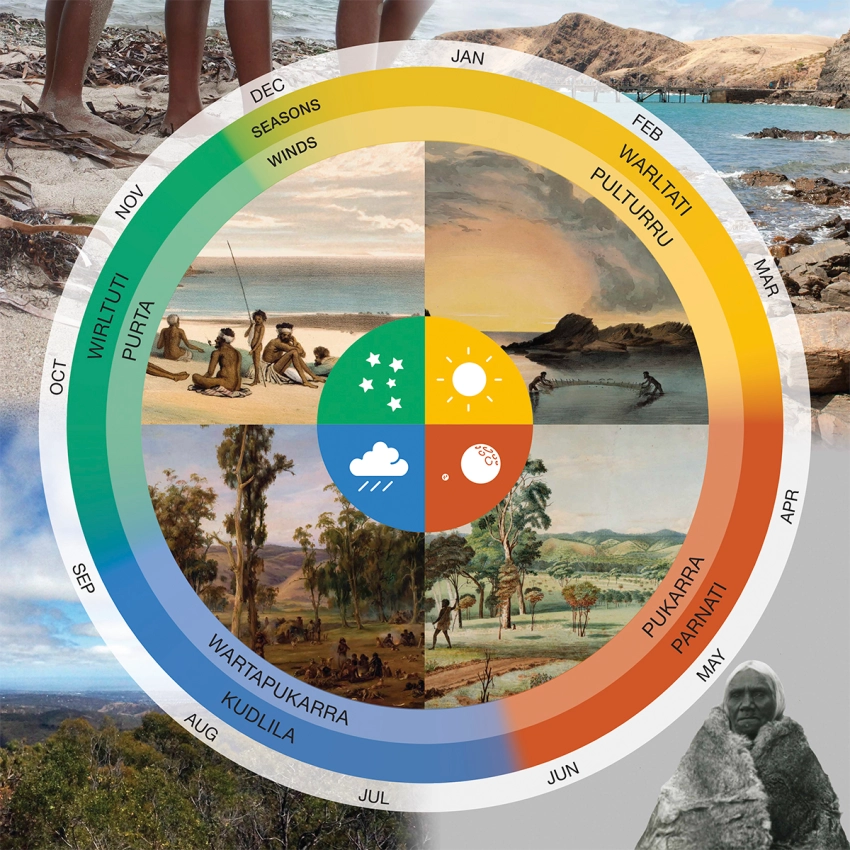
Not a good opening to the new year 2025. The mean for January, over the last 100+ years is 16.5mm & this year we reported 7.5mm.
This compares with other years back to 2012:
2025 7.5mm
2024 34.0mm
2023 11.5mm
2022 38.0mm (18.5mm TC Dump)
2021 12.0mm
2020 25.5mm
2019 1.0mm
2018 6.5mm
2017 62.0mm (21.0mm & 18.5mm TC Dumps)
2016 28.0mm
2015 31.0mm (20.0mm TC Dump)
2014 12.0mm
2013 7.0mm
2012 3.0mm
It is interesting that the three best years coincided with Tropical Cyclones out of the Broome area in Western Australia, that gave us dumps of 15.0mm’s or more.
We are now, from the 1st January into the Kaurna summer or ‘Waritati’. Waritati means hot, heat or warmth. The astronomical indicator is the Sun. The Sun crosses co-ordinates on the north west corner of Victoria Square in early January. There can be thunder (Piturru), lightning (Karntu) & dry breezes (Pulturru). Kangaroo was a major source of food. A conference for neighbouring nations was held to exchange knowledge & do some trading. Controlled low heat fires were lit in the foothills to prepare the land to ensure food supplies into winter & spring. The Grey Teal Ducks would migrate from the Murray Darling Basin northward in good years. Summer continues in to March.
Back to 2025. The Monsoon has been late this year with signs now that it is close to setting in. This means that Tropical Cyclones will commence as well. The heavy rains currently flooding Queensland’s north is evidence of this. Three TC’s formed well off the coast during the past week, none of which is likely to come ashore. The next eight weeks may see on come ashore & head down our way.
All the oceans are in neutral at present but the seas around Australia are very warm, including the Southern Ocean. This will help us hover around average rainfall in February & into autumn. The day & night time temperatures will be above average over summer but not as severe as will be the interior. Oodnadatta continues to be well over 40 degrees almost every day over the last eight weeks & towns down as far as Port Pirie & Whyalla have regularly recorded 40’s. Because of the ocean warmth we may have some thunder storms, hopefully with accompanying rain. Forecast models are tipping about average for Adelaide in terms of rainfall/showers this summer into autumn.
Our soils are very, very dry right down to deep sub-surfaces. You will have to water your gardens regularly. Deep watering each week is best rather than a sprinkling every other day. The compost & mulch you put on in last Spring will help to stop evaporation. DO NOT put mulch on your plants during winter or spring. The winter & spring rainfall needs to get into the ground first, THEN in late spring you add mulch to keep the water in the ground longer. ‘Read the land & take note of the science’ is the message contained in a book by Jackie French, I’ve just finished. It is available from the Willunga Environment Centre.
Anne & I have acquired some C4 native grasses recently which grow in summer. Species include Kangaroo Grass, Red Legged Grass, Lemon Grass, Windmill Grass & Bottle Washers Grass. We plan to seed some in pots & try our hand at direct seeding around the 20 or so Allocasuarina Verticillata (Drooping Sheoak), we’ve planted around the southern side of the Grevillia Dam. These can be watered at the same time the trees get a drink. This project is moving along well, improving our fire safety & returning the area to a grassy woodland that it would have been in 1836, before we ‘white people’ tried to tame nature. We also have quite a bit of C3 Wallaby Grass which grows in late winter.
That’s all for now, catch you in early March.
Paul





